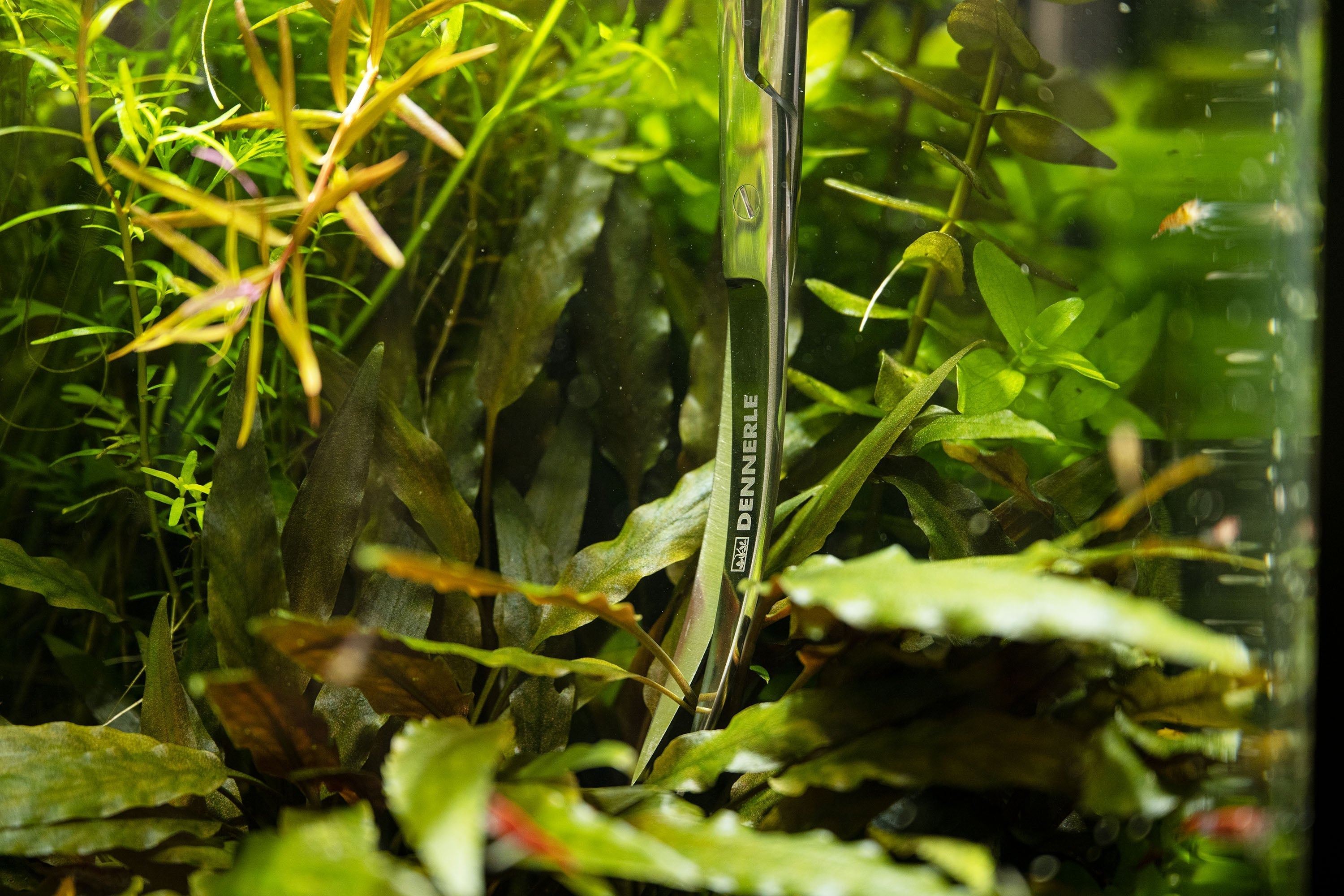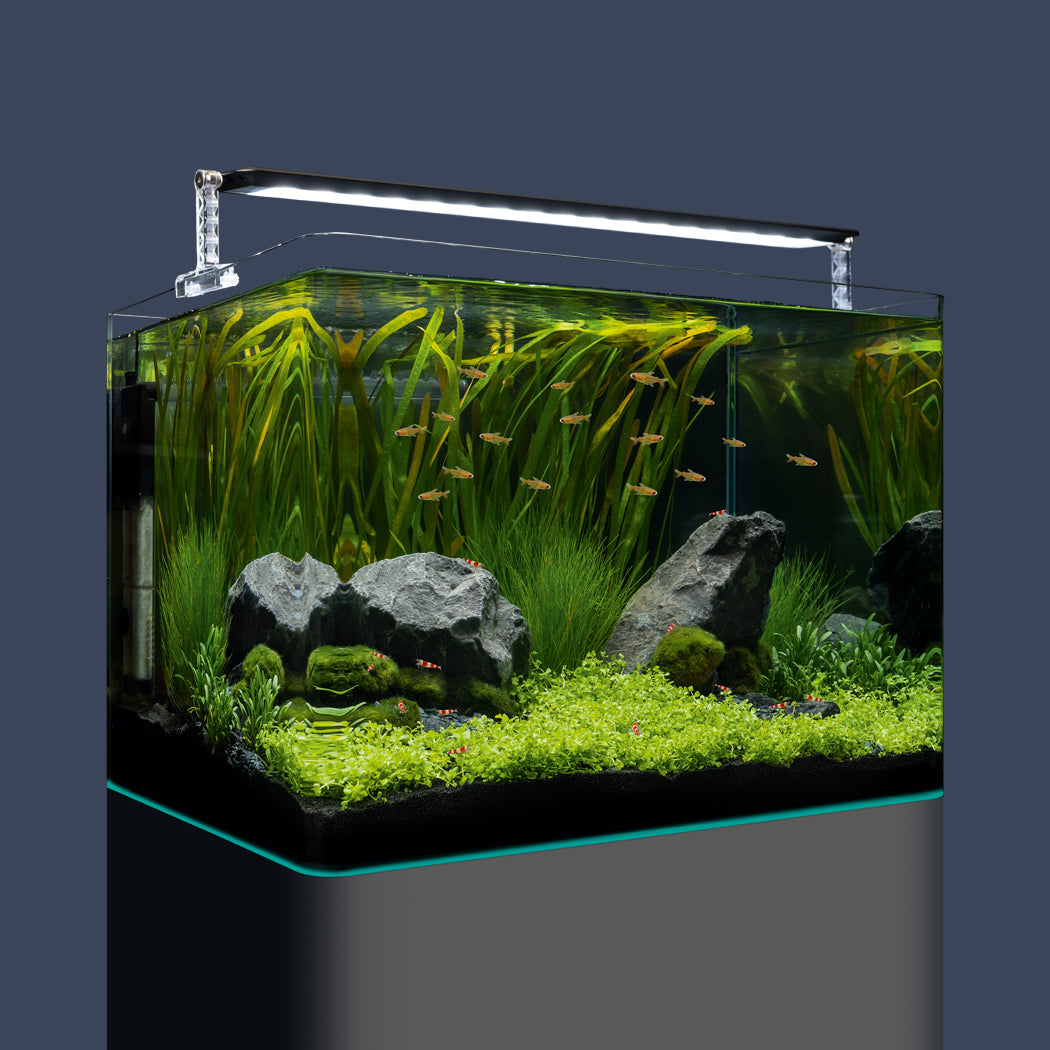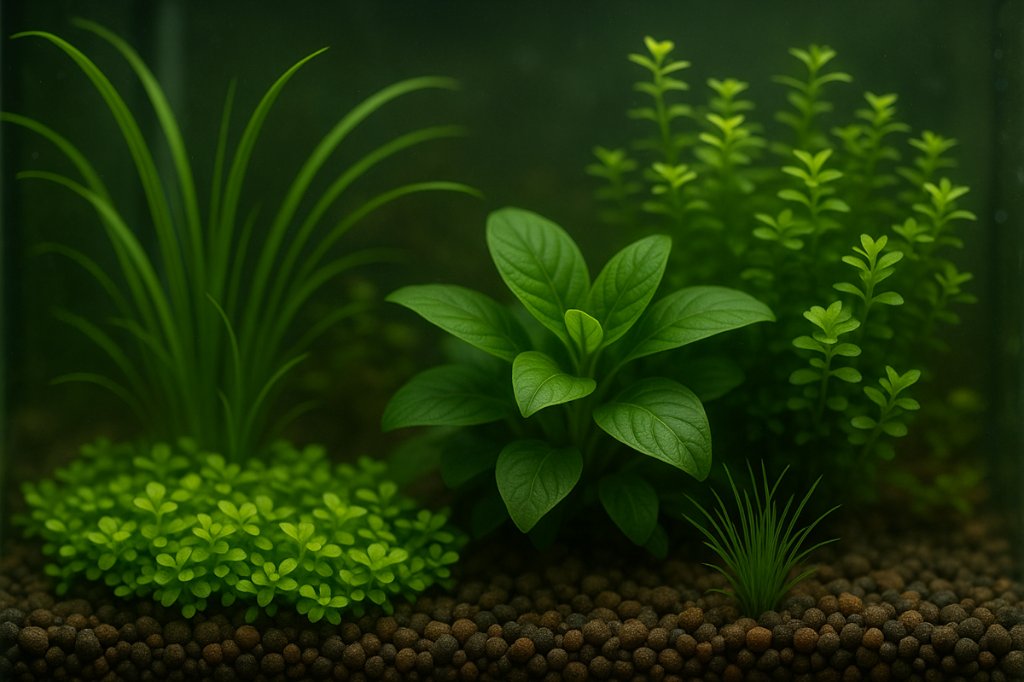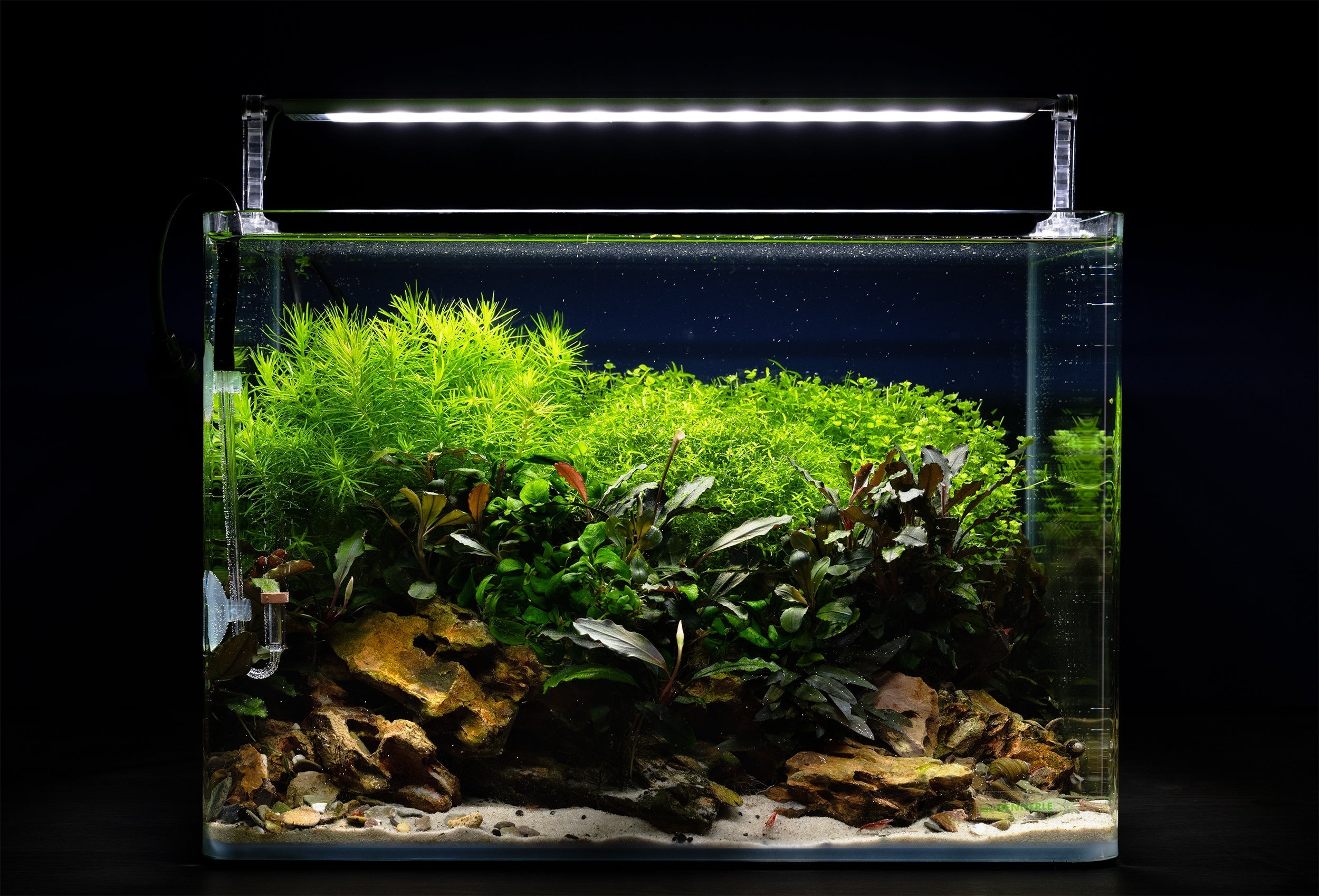If the plants are growing well, pruning is necessary approx. every 4 – 6 weeks.
For rosette plants such as Echinodorus (sword plants) or Cryptocorynes (water cups), cut off the outer, old leaves.
Stem plants should be cut back to 10 – 15 cm. They will sprout new shoots from the leaf axils. Depending on the species, this can be done several times. At some point, however, the base shoot loses its vigor and no longer looks attractive. The entire plant should then be removed and the cut shoot tips (cuttings) replanted.
Ground cover plants are cut back with scissors. The cut plant parts rise up and can simply be removed.
Dennerle offers suitable scissors and tweezers for easy plant care.
It is advisable never to cut back all the plants at once, but only a part at a time. A weakened plant population in combination with a significant change in nutrient consumption can possibly lead to algae growth.
The filter
The filter biologically breaks down harmful substances and ensures clear, clean water. A planted aquarium should have a constant but rather slow water movement. This brings nutrients to the plant leaves and removes waste products. It also ensures a certain amount of gas exchange at the water surface.
In planted aquaria, it is sufficient to filter the tank contents approx. 1 – 2 times per hour. The current should not be too strong, as most plants come from calm waters, not from white water streams. And: A filter must run continuously.
The way an aquarium filter works is often misunderstood. It is not the filter materials that clarify the water and remove pollutants, but the biology on it. All filter materials are overgrown with bacteria and other microorganisms. They are the ones that constantly filter the water and biodegrade pollutants.
A filter only works well when a sufficient biofilm and mulm have formed. Mulm is not “dirt”, but extremely important for the aquarium.
A mulm floc is full of life. It consists of bacteria, single-celled organisms, small multicellular organisms and other microorganisms, as well as minerals and dead plant parts. It is a small world of its own. Here, waste materials are naturally remineralized and converted back into plant nutrients. Mulm is a natural plant fertilizer, like compost for the aquarium.
For this reason, the filter should only be cleaned when the flow rate drops significantly. The filter material is best washed out in aquarium water as to not damage the filter bacteria. The filter material should not be cleaned too thoroughly so that enough bacteria remain. Or even better: only wash out part of it at a time. Under no circumstances should hot water or cleaning agents be used.
Ideal: For filters with 2 filter inserts (e.g. Dennerle Corner Filter 60), only clean or replace one insert at a time - this ensures that one remains fully biologically active.
The outlet opening of the filter should be 1 – 2 cm below the water level so that it doesn't create a rippling surface movement. This allows the water to absorb enough oxygen from the air without too much valuable CO2 being expelled. This is especially true at night. During the day, the plants usually produce excess oxygen.
Air-operated internal filters or aerators should be avoided. They expel too much CO2. Plants cannot grow under these conditions.
Mulm in and on the substrate is also biologically valuable. It stabilizes the entire aquarium. In addition, numerous microorganisms live in the mulm, which serve as valuable natural supplementary food for the fish. It should only ever be vacuumed when necessary and only superficially and partially. Never rearrange the entire substrate. A “clinically clean” aquarium won't function.
The water temperature
Most aquarium plants grow in a temperature range of 20 – 28 °C.
They grow more slowly at lower temperatures and faster at higher temperatures.
For (nano) aquaria with shrimps, snails or dwarf crayfish, the normal room temperature of 20 – 22 °C is sufficient. They don't need any additional heating.
Tropical fish like it warmer, here 24 – 25 °C is optimal. This temperature is also ideal for aquarium plants. Some fish, such as discus, require even higher temperatures of approx. 28 – 30 °C. This is where many aquarium plants reach their limits. Only particularly temperature-tolerant plants are therefore suitable for discus aquaria.
The light
Light provides the vital energy for plant growth. It is the fuel for photosynthesis. In the past, the rule of thumb for lighting with fluorescent lamps was approx. 0.5 watts per liter of aquarium water. This corresponds to medium-intensity lighting, under which most aquarium plants grow well.
Today, with powerful and energy-efficient LED lights, this no longer applies. The decisive factor is not the power a light consumes, but the amount of light it emits. The measure of this is the luminous flux, measured in lumens (lm). This information can be found on every lamp or luminaire packaging. Divide the specified lumens by the number of liters in the aquarium to obtain a good guide value for the illuminance:
- 15 lumen/L = weak lighting
- 30 lumen/L = medium lighting
- 60 lumen/L = strong lighting
Example: If a luminous flux of 3,200 lm is specified on the packaging of an LED light and the aquarium has a size of 100 L, then you will get an illuminance of 3,200 lm / 100 L = 32 lm/L, i.e. medium lighting.
Low lighting is sufficient for plants that require little light and slow-growing plants. We recommend medium lighting for planted community aquaria. Plants that require a lot of light and aquascaping aquaria require strong lighting.
Information on the light requirements of individual plant species can be found in the plant database, for example
It should also be noted that not all light is the same. Plants require certain spectral ranges for photosynthesis. Even if the light from two lamps looks the same to the observer, the spectra can have completely different compositions. Plants “see” light differently than humans. You should therefore make sure that the spectrum is suitable (see information on the packaging). With Dennerle you can be sure: All LED lights have a plant-friendly spectrum.
The lighting time
The lighting time should be 8 to 12 hours. A tropical day has 12 hours. However, the sun does not usually shine all day. It often rains for 1 – 2 hours a day. In addition, little light penetrates the water in the morning and evening hours due to the shallow angle of incidence. A daily lighting period of 10 hours has therefore proved to be a good idea.
Plants love a “midday break”, algae do not. During the lighting period, the plants' metabolism runs at full speed. Light means “real work” for the plants. This is another reason why they are grateful for a midday break. Here they can recover and break down harmful metabolic products (e.g. oxygen radicals).
Our recommendation: 5 hours light – 2 hours dark – 5 hours light.
The light rhythm in the aquarium doesn't have to correspond to the light rhythm outside. It can be selected so that the fish are still awake when you want to observe them in the evening, e.g.
- 10:00 – 15:00 Light ON
- 15:00 – 17:00 Light OFF (lunch break)
- 17:00 – 22:00 Light ON
Plants and fish also have a biorhythm. The lighting times should therefore be the same every day. A timer is recommended for this.
Tip for initial set-up: We recommend gradually increasing the lighting time from 8 to 10 hours/day during the start-up phase, i.e. within the first 4 – 5 weeks. This gives the plants more time to adapt and prevents algae growth.
The partial water change
One of the most important maintenance measures is regular partial water changes. In nature, waste products are transported away by the flowing water, rain brings fresh, clean water. Even the best filter cannot completely break down all pollutants. Many plants secrete inhibitors in order to gain an advantage over other plants (keyword: allelopathy). Such inhibitors can accumulate. Plant growth can then come to a standstill, even though sufficient nutrients, CO2 and light are available.
For this reason, 25 – 50% of the aquarium water should be replaced with temperate tap water (18 – 25 °C) at least every 2 weeks, but preferably once a week.
A regular partial water change is one of the basic requirements for healthy aquarium inhabitants and beautiful plants in the long term and also prevents algae problems.
It is best to set a specific day of the week as a “maintenance day”, e.g. always on Sundays. If the maintenance day is postponed for a few days or even a week due to time constraints, this is not a disadvantage. An aquarium that is biologically stable can cope with this without any problems.
The cleaning crew
The right choice of plants, the right amount of plants, appropriate lighting, regular fertilization and CO2 supply create the best conditions for a magnificent aquarium that runs smoothly. But even in such aquaria, some algae will grow from time to time, sometimes more, sometimes less, depending on the current conditions. This is completely normal and corresponds to the conditions in the wild. The aim is not an algae-free aquarium, but an aquarium with little algae.
A cleaning crew is particularly helpful and should not be missing in any aquarium.
Proven algae eaters are:
- Amano shrimps (Caridina multidentata) = Recommended stocking: 1 shrimp per 5 – 10 liters of aquarium water
- Otocinclus sp. = Recommended stocking (from aquarium size 55 L): 2 fish per 50 L of aquarium water
- Zebra racing snails (Vittina coromandeliana), antler snails (Clithon sp.) = Recommended stocking: 1 snail per 10-20 liters of aquarium water
- Dwarf shrimps (Neocaridina sp.) = Recommended stocking: 1 shrimp per 1 - 2 liters of aquarium water
The animals graze on all surfaces in the aquarium throughout the day and also keep the plant leaves clean.




Share:
Plant care – Part 4 – Dosage
Iron deficiency in the aquarium
1 comment
Guten Tag,
eine sehr ausführliche und hilfreiche Darstellung zur Aquaristik!
Vielen Dank und mit
freundlichen Grüßen